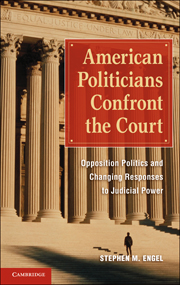 American Politicians Confront the Court
American Politicians Confront the Court Book contents
- Frontmatter
- Contents
- Acknowledgments
- Introduction
- PART I POLITICAL DEVELOPMENT AND ELECTED-BRANCH RELATIONS WITH THE JUDICIARY
- PART II HOSTILITY TO JUDICIAL AUTHORITY AND THE POLITICAL IDIOM OF CIVIC REPUBLICANISM
- PART III HARNESSING JUDICIAL POWER AND THE POLITICAL IDIOM OF LIBERAL PLURALISM
- 6 Clashing Progressive Solutions to the Political Problem of Judicial Power
- 7 A Polity Fully Developed for Harnessing (I)
- 8 A Polity Fully Developed for Harnessing (II)
- On the Return of Opposition Illegitimacy and the Prospects for New Development
- Index
- References
8 - A Polity Fully Developed for Harnessing (II)
A Conservative Insurgency Innovates and a Self-Styled Majoritarian Court Responds
Published online by Cambridge University Press: 05 June 2012
- Frontmatter
- Contents
- Acknowledgments
- Introduction
- PART I POLITICAL DEVELOPMENT AND ELECTED-BRANCH RELATIONS WITH THE JUDICIARY
- PART II HOSTILITY TO JUDICIAL AUTHORITY AND THE POLITICAL IDIOM OF CIVIC REPUBLICANISM
- PART III HARNESSING JUDICIAL POWER AND THE POLITICAL IDIOM OF LIBERAL PLURALISM
- 6 Clashing Progressive Solutions to the Political Problem of Judicial Power
- 7 A Polity Fully Developed for Harnessing (I)
- 8 A Polity Fully Developed for Harnessing (II)
- On the Return of Opposition Illegitimacy and the Prospects for New Development
- Index
- References
Summary
New Deal policy aims and the Court's post-1937 interpretive emphasis on living constitutionalism promoted specification of un-enumerated rights. Foremost among these contentious judicially constructed rights was a right to privacy, detailed in Griswold v. Connecticut. To avoid criticism plaguing the Lochner Court's discovery of un-enumerated rights within the Fourteenth Amendment's due process clause, such as liberty of contract, the majority in Griswold grounded its holding in constitutional text. Justice Douglas's ruling specified “penumbras” and “emanations” of the Bill of Rights suggesting a right to privacy. Justice Goldberg's concurrence, true to the precepts of living constitutionalism, anchored the right outside the text and in “‘the traditions and [collective] conscience of our people to determine whether a principle is ‘so rooted [there] … as to be ranked fundamental.’” Yet, to avoid falling prey to the claim that he was entrenching his own values, Goldberg argued that the right to privacy drew on the original meaning of the Ninth Amendment, which held that the rights enumerated in the first eight amendments did not constitute an exhaustive list, but that “others” are “retained by the people.” Of course, as Justices Black and Stewart's dissents made clear, simply referencing constitutional text in and of itself did not constitute valid interpretation. The living constitutionalist approaches of the majority “turn[ed] somersaults with history.”
For many legal scholars and judges, privacy doctrine represented the same challenges posed by unrestrained judicial power that liberals charged had been evident in Lochner-era rulings.
- Type
- Chapter
- Information
- American Politicians Confront the CourtOpposition Politics and Changing Responses to Judicial Power, pp. 337 - 371Publisher: Cambridge University PressPrint publication year: 2011


